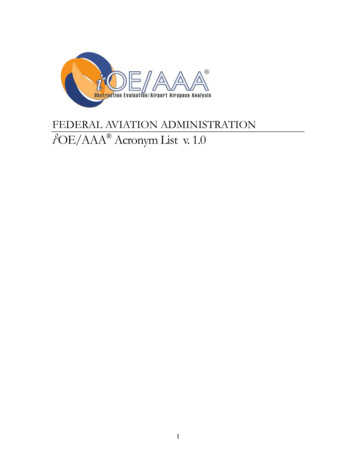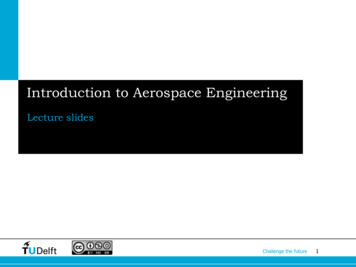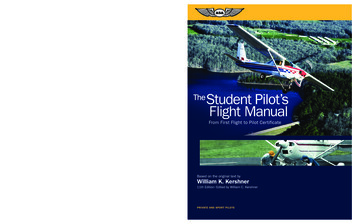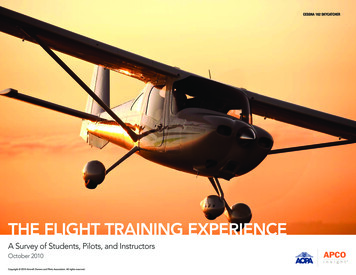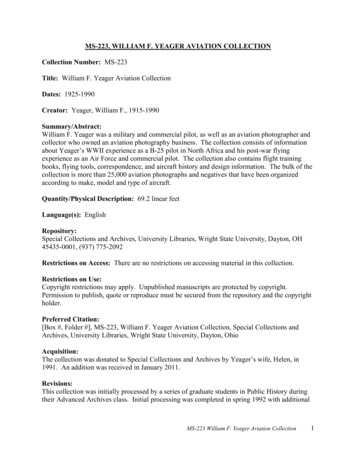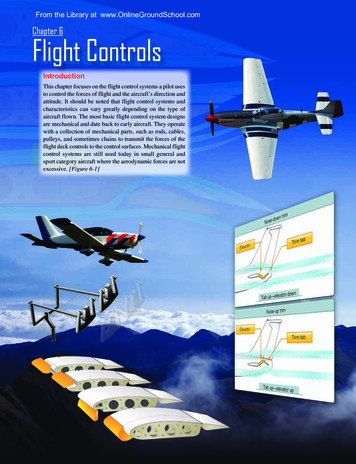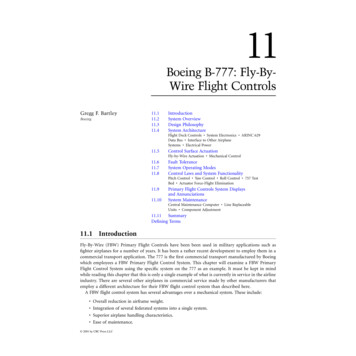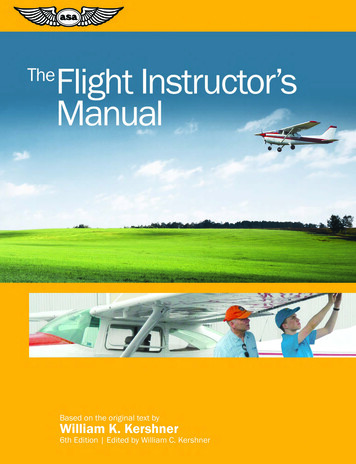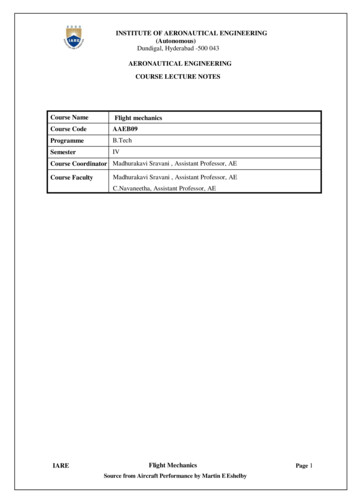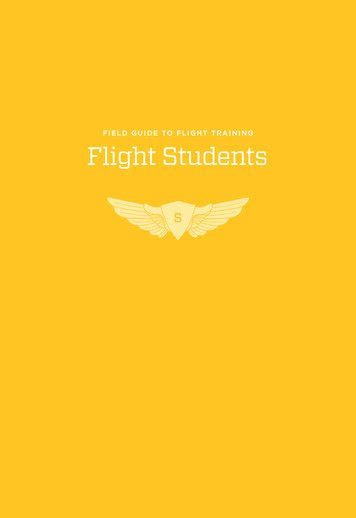
Transcription
fiel d g u i d e to f l i g ht t r a i n i n gFlight Students
Field Guide to Flight TrainingFlight Students
05In trodu c t i on06Section 1 THE F LI G HT TRAINING J OURNE Y10Worksheet Motivation and SkillsWhy fly?What can I do with my pilot certificate?What skills will I learn?12journ ey ov erv i ew14the nuts & boltsWho will help me?How much will flight training cost?What types of schools can I choose from?What types of certifications can I earn?24Section 2 SET YOUR P LAN S IN M OTION26Worksheet Identifying your Learning Style32Worksheet Opportunities for Growth34Section 3 C hoos e a Sc hool a nd I n str u c to r38Worksheet Choosing a Flight School48Worksheet Choosing a Flight Instructor54section 4 NAV I G ATIN G NEX T STEP S58a dventur e awa i ts
“Science,beauty,freedom,adventure.What morecould youask of life?”– Ch arles A. Lind bergh , aviator04
IntroductionFlight is a practice in dualities: land andsky, fore and aft, climbs and descents. Thesame can be said of flight training—it is aninspiring process that will encourage youto bring together unexpected aspects ofyour personality and skill.As you embark on your flight trainingjourney, you probably have your ownperspective on becoming a pilot. Maybeyou’ve spent years buffing up on the latesttechnologies in aviation. Maybe you can’thear a plane fly by without looking up andwondering what it would be like to takethe controls. Maybe you’re curious aboutthe process of earning your pilot certificate(often referred to as your “pilot license”),but you don’t know what it entails.Now it’s time to start taking action.This book will act as a guide as youtake your first steps toward becominga pilot. It will provide you with a setof tools to help you make the most ofyour flight training experience—fromsetting a budget to choosing a flightinstructor—and help you turn yourdreams into reality.Regardless of your reasons for exploringthe world of general aviation, you’ve foundyour way here.Now what?05
head. hands. heart.b e g i n yo u r f l i g h t t r a i n i n g j o u r n e y06
section 1Flight training will enrich your life incountless ways. You’ll learn to balancetechnical training with the freedom offlying towards an endless horizon.You’ll adopt new ways of speaking,navigating, and calculating yourposition. What initially feels like acomplex process will slowly becomesecond nature, and you will alwayshave a great story to tell.Through the course of your training, you will also have the chance to fostera close relationship with your flight instructor, who will act as your personalguide into the world of aviation.There are many reasons to become a pilot—but each journey is unique.So start thinking about your motivations, inspirations, and aspirations asa pilot. With this knowledge you can approach your training with a clearpurpose and open mind.07
“When once youhave tasted flight,you will foreverwalk the earthwith your eyesturned skyward,for there youhave been, andthere you willalways longto return.”–Leo nard o DaVinc i, inve ntor08
09
wo r ksheetm otivat i on s & s k il l sPeople choose to fly for many reasons. Use this worksheet to reflect on your motivations forbecoming a pilot. As you continue through your flight training program, this sheet will serve as areminder of why you first decided to pursue your dream, and help you keep sight of your traininggoals. This is a good resource to share with you instructor so he/she can tailor your training.why f ly?i want to fly so i c a n . . .Experience the world from a newvantage point.Fulfill a childhood dream.Fly loops and rolls.Meet new people, visit new places.Conquer my fear of heights.Begin a career in aviation.Enhance or build my business.Prove to myself that I can.Serve my community. . .i’m most excited a bout. . .Every takeoff. Every landing.The stories I will tell my family and friends.The first flight when the instructordoesn’t touch the controls.The day I hold my pilot certificatein my hand.My first solo flight.WHAT CAN I DO WITH MY P ILOT CERTIFICATE?It’s never too early to start exploring ways you can engage with aviation once you’vecompleted your flight certification. Mark the areas below that interest you.Plan a weekend getaway with my family—to the beach, the mountains, or a cityI’ve been wanting to explore.Participate in Fly Out events and meet up with pilots at a neighboring airport.Go out for lunch at an airport restaurant a few towns away.10
Earn my Instrument Rating so I can fly in low visibility and cloud cover.Continue my flight training to eventually become a flight instructor orcommercial pilot.Leverage travel freedom to enhance my businessAddit ion a l ideas. . . . . . . . . . . . . . . . . . . . . . . . . . . . . . . . . . . . . . . . . . . . . . . . . . . . . . . . . . . . . . . . . . . . . . . . . . . . . . . . . . . . . . . . . . . . . . . . .SKILLS & KNOW- HOWHere are just a few of the skills you can learn as a part of flight training. Which onesare you excited about?Mathematical reasoningSpatial awarenessSituational awarenessCommunicating with air traffic controlExpertise in aviation standards and regulationsScience, physics, and engineering knowledgeMechanical proficiencyAttention to detailTroubleshootingCritical thinkingContingency planningAbility to see the big pictureUnderstanding of aviation acronyms and alphabet11
You’ll be taking the controlsfrom Day 1. In fact, it’s notuncommon to take off, fly,and even land the planeduring your introductoryflight lesson.During the first solo flight, studentstypically perform three takeoffs andlandings, while the instructorwatches from the ground. This is anexciting accomplishment thatshowcases all the hard work andtraining you’ve done up to this point.Student Pilot Certificate(Medical Exam)You will start building youraviation knowledge duringthe first part of your trainingexperience. As you learn newskills and theories, it’s helpfulto review these techniquesfrequently, and bring theminto your flight trainingpractice.As a prerequisite for solo flight,students pursuing a private pilotcertificate must pass a basicmedical exam which also servesas their student pilot certificate.Students pursuing a sport pilotcertifcate don’t need to pass themedical exam.See Appendix on page 58 formore information.Fly to OtherAirports(Cross-Country)Often referred to as a“cross-country” flight,you will learn how tonavigate to,communicate with,and land at otherairports as a part ofyour flight training.Simulators can help youpractice your trainingskills and techniques onthe ground—whetheryou use a computerprogram at home or asimulator at your flightschool.
Practice FlyingManeuvers & LandingOnce you’ve done your soloand cross-country flights,you’ll spend time practicingyour maneuvers in preparationfor your checkride. During thistime, your flights will be a mixof solos, and flight lessonswith your instructor.Written ExamOnce you’ve completedyour ground school training,you will take the “written”test—a computer-basedmultiple choice examcreated by the FAA (FederalAviation Administration).It will test your knowledgeof the theories covered inground school.The “checkride” is an oraland practical test of youraviation skills—and itbrings together elementsfrom every aspect ofyour training. Duringyour checkride you’ll flywith an FAA DesignatedExaminer who willmeasure your skillsagainst Practical TestStandards for pilotcertification. In additionto observing yourtechnique as a pilot, theexaminer will ask youquestions to evaluateyour knowledge ofaviation theory.Go Explore;Keep LearningPilot certificationis just the beginningof your journey as anaviator. Whether youcontinue your trainingto earn other ratingsand certificates or shareyour passion for flyingwith friends and family,there are countlessways to engage withaviation beyond yourinitial training.13
14
f l i g h t t r a i n i ng : t h e n u t s & bo lt sTHEINTRODUCTORYFLIGHTNo matter how far aviation takes you,your introductory flight will remain atreasured memory. The intro flight is abrief but comprehensive introduction tothe complete experience of a flight lesson.Your flight instructor will give you anoverview of preparatory steps, such aschecking the weather and performinga preflight inspection of the aircraftyou will fly. Since training aircraft areequipped with dual controls, you will bea participant from start to finish. You’llget a taste of the fundamentals of flying—not to mention an incomparable viewof your local area. And you’ll have anamazing answer to the question,“What did you do today?”15
Who will help me?Yo u r flight trai n i n g g ui d es, g r oup s,and ground supp ortF l ight Schools &F lying ClubsF l i g ht i n str u c to r sYour flight school or flying club isthe nerve center of the flight trainingexperience. It’s a place to field questions,give and get feedback, and ask about thelong-term experiences and costs of yourflight training. It’s also the perfect placeto take a curious family member or friendwho wants to know more about yourflight training.Your flight instructor is your go-to personfor any questions pertaining to yourparticular flight training program. A goodinstructor ensures that you gain hands-onexperience in the air, makes you feel safe,and encourages you to be honest aboutyour particular challenges and passions.Using one instructor for your trainingmaintains consistency, but using multipleinstructors allows for schedule flexibilityand broadened resources.16
f l i g h t t r a i n i ng : t h e n u t s & bo lt sot h er flight stude n tsF r i en ds & Fam i lyYour fellow flight students can bea valuable resource and supportthroughout your training. Ask yourinstructor or flight school to introduceyou to some of their other students.Online communities like myft.org canalso provide support. Whether you askfor advice from someone further alongin training, trade stories or comparelogbooks, it’s always inspiring to find agroup of pilot friends who also have theaviation bug.Your friends and family play an importantrole in your flight training experiencebecause they act as a natural supportsystem as you challenge yourself in newways. Even if they don’t understand thetechnicalities of flight training, includeyour friends and family in the conversationby sharing photos and experiences. Onceyou feel comfortable, you can even invitethem along for a training flight. Share yourpassion and progress with your friends andfamily—in person, online, and any otherway you see fit.pilotsConnecting with pilots is a greatway to engage with the aviationcommunity, get a sense of where youcan go with your pilot certificate, andgarner wisdom from those who havelogged many hours in the air. Don’thesitate to join a pilot association orapproach your fellow pilots at hangarevents, airport days or even aroundthe airport.17
HOW MUCH WILLFLIGHT TRAINING COST?Many variables affect the cost of learning to fly, including the frequency of flightlessons, weather conditions, where you fly, your training aircraft, and individualaptitude. The cost of earning your certificate ranges between 5,000 and 15,000,depending on whether you choose to pursue sport, recreational, or private pilottraining. (See page 21 for an overview of each of these certifications.)If you fly more often (multiple times per week, or more), you’ll actually end up spending less money on your flight training. Typically, when you consistently reinforce yourtraining, you don’t have to spend air time re-learning skills or techniques. Instead, youcan continue to move forward and make the most of every moment in flight.Calculatin g hou r sTotal hours in flight refers to the amount of time that you spend in the airplane withthe propeller spinning. Remember that you will spend time on the ground during eachlesson with your instructor. This time will be spent prepping the plane, covering newflight training theories, and reviewing material.Lo c ation , locati on , loc at i onInstructor and airplane costs vary depending on where you are located. Check withlocal flight schools to get an estimate of airplane rental and instructor rates, andcalculate your budget accordingly.F o r a list of fli g ht s c hool s a n d i n st r u c to r snear you, uctor18
f l i g h t t r a i n i ng : t h e n u t s & bo lt sMak e a n estimateUse this formula to calculate your flight training cost. Don’t hesitate to ask your flightschool or instructor for an estimate.Remember, often your instructor will cover important skills and techniques on the groundbefore and after each flight. Most instructors include this time—as well as time in the air—when calculating their billable hours.total hours in flightxairplane rate total hourswith instructorxinstructor rate flight training costBu il d your budgetSet aside room in your budget for these additional flight training costs.Examiner and test feesBooks and resourcesAviation headsetInsurance (if applicable)Simulator practice costs19
WHAT TYPES OF SCHOOLSCAN I CHOOSE FROM?As a flight student, you can choose from two types of flight schools:Par t 141 & Part 61These names refer to the parts of the federal aviation regulations (FARs) under which theschools operate.The most relevant differences between the two are structure and FAA oversight.Part 141 flight schools are periodically audited by the FAA, must have detailedFAA-approved course outlines, and are required to meet student pilot performancerates. Part 141 schools might be better for you if you prefer a more structuredenvironment or want to fly professionally.Part 61 flight schools and independent flight instructors do not have the same paperwork requirements and FAA oversight as Part 141 schools. Learning at a Part 61 schoolcan give students the flexibility to adapt flying lesson content and sequence to meet theirneeds. For this reason, many part-time students choose to enroll in Part 61 schools.The most commonly mentioned (but least important) distinction between the two is theminimum flight time required for the private pilot certificate—40 hours under Part 61,and 35 hours under Part 141. However, considering that the national average for earninga private pilot certificate is 60-75 flight hours, this difference isn’t the most importantfactor for choosing a school.Your choice of flight school depends on your goals, personal preferences, available time,location, and other factors that fit your specific needs.20
f l i g h t t r a i n i ng : t h e n u t s & bo lt sWHAT TYPES OFCERTIFICATES CAN I EARN?P r ivat eMost flight students in the United States earn a traditional private pilotcertificate. This is often referred to as “having your private.” It has the fewestlimitations and, with additional training, can be upgraded to include moreadvanced capabilities such as flying through clouds, flying an airplane with twoor more engines, or flying professionally. The minimum flight time requirementto be eligible for a private pilot certificate is 40 flight hours. Most students fly60-75 hours before testing.Rec reationalThe recreational pilot certificate is a more limited form of the private certificate.It’s a great way to earn your wings if you’ll be flying close to your home airportduring the day with no more than one passenger. It requires less time and moneyto earn than the private. Most people who start down this path eventually go onto earn the private certificate. If you become a recreational pilot, additional training and experience will allow you to easily upgrade to a private pilot certificate.The minimum flight time required to be eligible for a recreational certificate is 30hours. Like the private certificate, most students budget for more hours of flighttraining time.Spo r tThe sport pilot certificate is perfect for people who want to get back to—or startwith—the basics of flying. Sport pilots can fly a specific limited class of aircraftknown as light sport aircraft (LSA). These are smaller, lighter, less complex, oneor two-seat airplanes. Because light sport aircraft recently entered the industry,not every flight school will have them available. Sport pilots are not required tohave medical certificates. With additional training and a medical certificate, youcan easily upgrade to less restrictive certificates. The minimum flight time required to be eligible for a sport pilot certificate is 20 hours. Most students budgetfor more hours of flight training time.21
“To most pthe sky islimit. To twho lovethe sky is–A n on y m o u s
people,s thethosee aviation,s home.”23
Chart Your TrajectoryS e t yo u r p l a n s i n m o t i o n24
section 2Now that you have a sense of what theflight training journey entails, it’s timeto set your plans in motion. Use theworksheets in this section to get a senseof a training style that works for you,organize your training schedule, andbegin to share your flight trainingexperience with friends and family.25
wo r ksheetid entify i n g yourl e ar nin g st y l eAviation involves a great deal of skill and technical training. Through the course ofyour training you’ll develop the confidence, knowledge, and self-discipline required of asuccessful pilot.Take a moment to think about your work habits and learning style, so you can tackle yourtraining in a manner that’s most effective for you.t ips for successAre you better at working in a group or alone? Do you prefer to work at your own pace,or do you like having a set schedule when you learn new information? How do you bestreceive information?Think about the last time you learned a new skill—whether it was a computer programfor work or the best method for grilling a steak. Write about your learning experiencebelow. Share this sheet with your instructor as a conversation-starter about yourpreferred learning methods.Th e last new ski l l I l ea r n ed was .How did you learn this skill?. . . . . . . . . . . . . . . . . . . . . . . . . . . . . . . . . .Did you enjoy learning in this way? Why?. . . . . . . . . . . . . . . . . . . . . . . . . . . . . . . . . . . . . . . . . . . . . . . . . . . . . . . . . . . . . . . . . . . . . . . . . . . . . . . . . . . . . . . . . . . . . . . . . . . .What resources do you wish you had access to during this experience? . . . . . . . . . . . . . . . . . . . . . . . . . . . . . . . . . . . .26
set your plans in motionbe h o n estBe honest with yourself about your schedule and limitations—and then focus onareas where you can make small changes to fit aviation into your life. Maybe you planmid-week flight lessons one evening a week. Maybe you devote 30 minutes of your TVtime to studying course material instead. Whatever you do, remember that all of thesesmall changes accomplish a much larger dream.Write down some small ways you can fit aviation into your life. . . . . . . . . . . . . . . . . . . . . . . . . . . . . . . . . . . . . . . . . . . . . . . . . . . . . . . . . . . . . . . . . . . . . . . . . . . . . . . . . . . . . . . . . . . . . . . . . . . . . . .Sh are the ex perien c eTell your friends and family about your flight training goals and experiences. Announcingyour milestones to the world will help keep you accountable and motivate you.Write down the names of people you’d like to share this experience with—or tell yourentire social media network. . . . . . . . . . . . . . . . . . . . . . . . . . . . . . . . . . . . . . . . . . . . . . . . . . . . . . . . . . . . . . . . . . . . . . . . . . . . . . . . . . . . . . . . . . . . . . . . . . . . . . . . . . . . . . . . . . . . . . . . . . . . . . . . . . . . . . . . .27
start it off rightTake a look at your weekly schedule and find a consistent time that will workfor your flight training lessons. (It’s often possible to schedule morning or eveninglessons during the week.)Discuss this plan with your family or significant other. Once you’ve chosen a goodtime for your training, share your calendar with your flight instructor to ensure that yourschedules line up. Keep in mind that the weather will constantly play a factor in yourability to fly. It’s often a good idea to schedule additional flight lessons, knowing thatsometimes you’ll be “weathered out” and will have to cancel a flight.Pl an Ahea dBe mindful of upcoming events or time commitments that might interfere with your flighttraining, and think about how you can plan around these commitments.Upcoming events. . . . . . . . . . . . . . . . . . . . . . . . . . . . . . . . . . . . . . . . . . . . . . . . . . . . . . . . . . . . . . . . . . . . . . . . . . . . . . . . . . . . . . . . . . . . . . . . . . . . . . . . . . . . . . . . . . . . . . . . . . . . . . . . . . . . .Int roductory fl i g ht sc hed ul ed for . .28
set your plans in motionsatSunmontuewedthufri29
SAFETY STANDARDSCompared to automobiles, general aviation—defined as all kinds of flying exceptfor the airlines and military—has about one-tenth as many accidents on a per-vehicle-milebasis, and the accident rate has dropped steadily since 1980. There are several reasonsfor this stellar safety record. Training for a pilot certificate is much more rigorous thanit is for a driver’s license. Mandatory ground and flight training, along with writtenand practical tests, ensure pilots have achieved a basic level of proficiency. Periodic,recurrent training helps maintain and improve skills so pilots are safe in the air.30
set your plans in motionmo ney matters“When I came back to flyingafter 38 years, I had some moneyset aside and I had a plan. First theknowledge test. If I wouldn’t studyfor that this time around, no flying.After I passed the test, I searcheddiligently for the cheapest plane inmy area—a Cessna 152. (Thankfully,the plane is owned by one of thebest CFIs in town!) I use flightsimulator software betweenlessons to practice whateverI’m learning.”–R e g i n a Co k e r“I budget a certain amount monthly.This enables me to complete myprivate pilot certificate in whatevertime it takes, and allows me tocontinue flying thereafter.”–B re tt Spr i n g a l l31
wo r ksheetOppor t un i t i e sfor G r ow t hYou’ll finish your flight training with more than a pilot certificate. You’ll have a greaterunderstanding of yourself and your capabilities. This is because flight training challengesand inspires each student in a different way.Take a minute to explore the areas in which you’d like to grow through flight training.Which of the challenges below resonate with you? Mark the areas you’d like to focus on,and then share this sheet with your flight instructor or flight school operator.I’m concerned about the amount of time flight training takes.I’m worried about the cost of flight training.Heights make me nervous.I think I might make a mistake or get lost when I’m flying.I’m nervous about speaking on the radio.Math isn’t my strongest suit.I’m concerned that I won’t be able to finish training once I start.I’m afraid of flying. . . . . . . . . . . . . . . . . . . . . . . . . . . . . . . . . . . . . . . . . . . . . . . . . . . . . . . . . . . . . . . . .Fo r more reading a bout n at ur a l f ea r s r e l ate dto f light, 32
set your plans in motion“My favorite aviation activityis planning for a cross-countryflight. It covers all aspects offlight, from the romanticdaydreaming of where youwant to fly, to the practicalcalculations of fuel, distance,and aircraft performance.It takes you out of yourcomfort zone; it forces youto plan ahead, work withother pilots in unfamiliarairspace, and each flight istruly an adventure.”–A me l ia R os e E a r h a rt33
MEET YOUR MATCHC h o os i n g a f l i g h t s c h o o l a n d i n st r u c to rt h at w o r k f o r yo u34
section 3As a student, you have control over twoof the most important factors in your flighttraining experience: you get to chooseyour flight school and flight instructor.Where you learn plays an important role in your overall training experience,satisfaction, and success as a pilot. Like any major investment, the best way tomake an informed decision is by doing some comparison shopping.Whether you choose to learn from an independent flight instructor at your localairport or instructor at a flight school, your seach should involve the same array ofquestions. The worksheets in this section are designed to help you choose a schooland an instructor that are right for you.35
“A mile ofroad willtake youa mile, buta mile ofrunway cantake youanywhere.”–ano nym o us36
choose a school & instructorHow to use these wor ksheetsEngage, Your WayC hoos e W i s e lyDepending on where you live, you mighthave many options for flight training—orjust a few. No matter what your situationis, make sure you investigate your options.In addition to assessing your instructor’sexperience, it’s important to get a senseof his or her passions, technique, andinstructor philosophy. Through thisprocess of careful comparison, you canselect someone who matches yourpersonality, as well as your needs.Co mpare & Con trastK eep i t OpenIt’s okay if a school or instructor doesn’tfulfill every single requirement orcheckbox. By using these worksheetsyou’ll know what to ask, understand howto compare your options, and learn whatmatters most to you.As you continue through your training,you can change instructors, and evenschools, if you feel that you’re not gettingwhat you need from your training.Fo r a list of fligh t sc hool s n ea r you, v i s i r37
flight school 1c hoosi n g a f l i gh t s c h o o lA i r p o rtlocati ondi stanc e f rom h ome. . . . . . . . . . . . . . . . . . . . . . . . . . . . . . . . .Timing & CostsHow many hours does it usually taketo complete flight training at your school?.What is the estimated cost of completing pilot certification?. .Is this estimate based on FAAminimum hours or your school’s average?.How many flight instructors does yourCan you tell me about their experienceschool have?. and personalities?.I nst r uc to r n a m enotes. . . . . . . . . . . .
Student Pilot Certificate (Medical Exam) As a prerequisite for solo flight, students pursuing a private pilot certificate must pass a basic medical exam which also serves as their student pilot certificate. Students pursuing a sport pilot certifcate don’t need to pass the medical exam.
